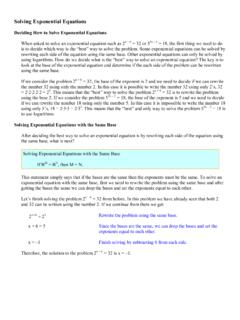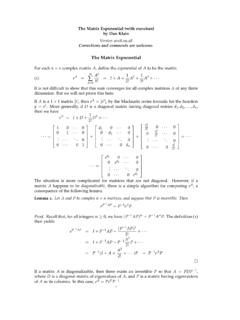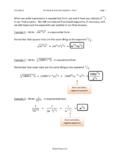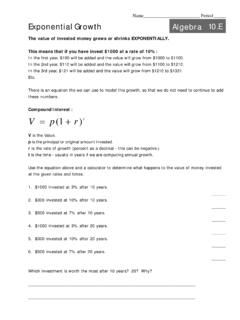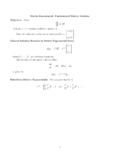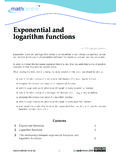Transcription of Time series Forecasting using Holt-Winters Exponential ...
1 Time series Forecasting using Holt-WintersExponential SmoothingPrajakta S. Kalekar(04329008)Kanwal Rekhi School of Information TechnologyUnder the guidance 6, 2004 AbstractMany industrial time series exhibit seasonal behavior, such as demand for apparel or , seasonal Forecasting problems are of considerable importance. This report con-centrates on the analysis of seasonal time series data using Holt-Winters Exponential smoothingmethods. Two models discussed here are theMultiplicative Seasonal Modeland theAdditiveSeasonal IntroductionForecasting involves making projections about futureperformance on the basis of historical and current the result of an action is of consequence, but cannot be known in advance with precision, Forecasting may reduce decision risk by supplying additional information about the possible data have been captured for the time series to be forecasted, the analyst s next step isto select a model for Forecasting .
2 Various statistical and graphic techniques may be useful to theanalyst in the selection process. The best place to start with any time series Forecasting analysis isto graph sequence plots of the time series to be forecasted. A sequence plot is a graph of the dataseries values, usually on the vertical axis, against time usually on the horizontal axis. The purposeof the sequence plot is to give the analyst a visual impression of the nature of the time series . Thisvisual impression should suggest to the analyst whether there are certain behavioral components present within the time series . Some of these components such astrendandseasonalityare discussedlater in the report. The presence/absence of such components can help the analyst in selecting themodel with the potential to produce the best selecting a model, the next step is its specification. The process of specifying a fore-casting model involves selecting the variables to be included, selecting the form of the equation ofrelationship, and estimating the values of the parameters in that the model is specified, its performance characteristics should be verified or validated bycomparison of its forecasts with historical data for the process it was designed to forecast.
3 Errormeasures such as MAPE1, RAE2, MSE3maybe used for validating the model. Selection of an error1 Mean absolute percentage error2 Relative absolute error3 Mean square error1measure has an important effect on the conclusions about which of a set of Forecasting methods ismost accurateTime- series Forecasting assumes that a time series is a combination of a pattern and somerandom error. The goal is to separate the pattern from the error by understanding the pattern strend, its long-term increase or decrease, and its seasonality, the change caused by seasonal factorssuch as fluctuations in use and methods of time series Forecasting are available such as the Moving Averages method,Linear Regression with Time, Exponential smoothing etc. This report concentrates on the Holt-Winters Exponential smoothing technique as applied to time series that exhibit Basic TerminologyThe following keywords are used throughout the Additive and multiplicative seasonalityOften, time series data display behavior that is seasonal.
4 Seasonality is defined to be the tendencyof time- series data to exhibit behavior that repeats itself everyLperiods. The term season is usedto represent the period of time before behavior begins to repeat therefore the seasonlength in periods. For example, annual sales of toys will probably peak in the months of Novemberand December, and perhaps during the summer (with a much smaller peak). This pattern is likelyto repeat every year, however, the relative amount of increase in sales during December may slowlychange from year to example, during the month of December the sales for a particular toy may increase by 1million dollars every year. Thus, we could add to our forecasts for every December the amount of1 million dollars (over the respective annual average) to account for this seasonal fluctuation. Inthis case, the seasonality is , during the month of December the sales for a particular toy may increase by 40%,that is, increase by a factor of Thus, when the sales for the toy are generally weak, then theabsolute (dollar) increase in sales during December will be relatively weak (but the percentage willbe constant); if the sales of the toy are strong, then the absolute (dollar) increase in sales will beproportionately greater.
5 Again, in this case the sales increase by a certain factor, and the seasonalcomponent is thus multiplicative in nature ( , the multiplicative seasonal component in this casewould be ).In plots of the series , the distinguishing characteristic between these two types of seasonalcomponents is that in the additive case, the series shows steady seasonal fluctuations, regardless ofthe overall level of the series ; in the multiplicative case, the size of the seasonal fluctuations vary,depending on the overall level of the Linear, Exponential , and damped trendTo continue with the toy example above, the sales for a toy can show alinear upward trend( ,each year, sales increase by 1 million dollars), Exponential growth( , each year, sales increase bya factor of ), or adamped trend(during the first year sales increase by 1 million dollars; duringthe second year the increase is only 80% over the previous year, , $800,000; during the next yearit is again 80% over the previous year, , $800,000 *.)
6 8 = $640,000; etc.). Seasonality Index (SI)Seasonality Index of a period indicates how much this period typically deviates from the annualaverage. At least one full season of data is required for computation of StationarityTo perform Forecasting , most techniques require the stationarity conditions to be satisfied. First Order StationaryA time series is a first order stationary if expected value of X(t) remains same for all t. Forexample in economic time series , a process is first order stationary when we remove any kindsof trend by some mechanisms such as differencing. Second Order StationaryA time series is a second order stationary if it is first order stationary and covariance betweenX(t) and X(s) is function of length (t-s) only. Again, in economic time series , a process issecond order stationary when we stabilize also its variance by some kind of transformations,such as taking square Exponential smoothingExponential smoothing is a procedure for continually revising a forecast in the light of more recentexperience.
7 Exponential smoothing assigns exponentially decreasing weights as the observation getolder. In other words, recent observations are given relatively more weight in Forecasting than theolder Single Exponential smoothingThis is also known as simple Exponential smoothing . Simple smoothing is used for short-rangeforecasting, usually just one month into the future. The model assumes that the data fluctuatesaround a reasonably stable mean (no trend or consistent pattern of growth).The specific formula for simple Exponential smoothing is:St= Xt+ (1 ) St 1(1)When applied recursively to each successive observation in the series , each new smoothed value(forecast) is computed as the weighted average of the current observation and the previous smoothedobservation; the previous smoothed observation was computed in turn from the previous observedvalue and the smoothed value before the previous observation, and so , in effect, each smoothed value is the weighted average of the previous observations,where the weights decrease exponentially depending on the value of parameter ( ).
8 If it is equalto 1 (one) then the previous observations are ignored entirely; if it is equal to 0 (zero), then thecurrent observation is ignored entirely, and the smoothed value consists entirely of the previoussmoothed value (which in turn is computed from the smoothed observation before it, and so on;thus all smoothed values will be equal to the initial smoothed valueS0). In-between values willproduce intermediate ValueThe initial value ofStplays an important role in computing all the subsequent values. Setting ittoy1is one method of initialization. Another possibility would be to average the first four or smaller the value of , the more important is the selection of the initial value Double Exponential SmoothingThis method is used when the data shows a trend. Exponential smoothing with a trend worksmuch like simple smoothing except that two components must be updated each period -leveland3trend.
9 The level is a smoothed estimate of the value of the data at the end of each period. Thetrend is a smoothed estimate of average growth at the end of each period. The specific formula forsimple Exponential smoothing is:St= yt+ (1 ) (St 1+bt 1) 0< <1(2)bt= (St St 1) + (1 ) bt 10< <1(3)Note that the current value of the series is used to calculate its smoothed value replacement indouble Exponential ValuesThere are several methods to choose the initial values in general set suggestions forb1b1=y2 y1b1= [(y2 y1) + (y3 y2) + (y4 y3)]/3b1= (yn y1)/(n 1) Triple Exponential SmoothingThis method is used when the data showstrendandseasonality. To handle seasonality, we have toadd a third parameter. We now introduce a third equation to take care of seasonality. The resultingset of equations is called the Holt-Winters (HW) method after the names of the inventors. Thereare two main HW models, depending on the type of seasonality (Section ).
10 Multiplicative Seasonal Model Additive Seasonal ModelThe rest of the report focuses on these two Multiplicative Seasonal ModelThis model is used when the data exhibits Multiplicative seasonality as discussed in Section OverviewIn this model, we assume that the time series is represented by the modelyt= (b1+b2t)St+ t(4)Whereb1is the base signal also called thepermanent componentb2is a linear trend componentStis a multiplicative seasonal factor tis the random error componentLet the length of the season seasonal factors are defined so that they sum to the length of the season, 1 t LSt=L(5)The trend componentb2if deemed unnecessary, maybe deleted from the Application of the modelThe multiplicative seasonal model is appropriate for a time series in which the amplitude of theseasonal pattern is proportional to the average level of the series , a time series displayingmultiplicative seasonality.
